
Motorola Razr 2020 review: The iconic flip phone has done it again, this time with 5G
The new Motorola Razr 2020 addresses most of the issues I had with the Razr (2019) that came out in February. Overall it's a better phone. The new Razr gets a slew of upgraded specs, but lacks the top of the line ones found in the Motorola Edge Plus and Samsung Galaxy Note 20 Ultra. But neither of those phones can fold into something incredibly small.
With the Razr you're paying $1,400 (£1,399, which is about AU$2,470) for a foldable screen. And that's important to remember because there isn't wireless charging or a high refresh rate display, or a gigantic battery or IP-rated water and dust resistance, or a headphone jack or headphones or the most powerful Snapdragon processor. If you want to fold a 6.2-inch phone into something the size of a small drink coaster in 2020, you're going to pay a lot of money.
The Razr's refined foldable flip phone feels fantastic to use. With the new cameras, addition of support for 5G and all the useful enhancements to the external display, the Razr feels like a "normal" phone that can do "normal" everyday stuff with its "anything but normal" foldable build. If I were to compare the Razr to a car, it would be a fun two-seat convertible.
But not everything is rosy with this new Razr. The speaker in the chin is OK, but doesn't produce great-sounding audio at louder volumes. The glass on the back of my review unit has accumulated a few scuffs over 10 days. They're barely visible, but they're there. A case could have prevented these and Motorola will sell a nifty $50 case for the Razr.
Also, when I opened and closed my 2019 Razr review unit in February it made this weird loud squeak. For the most part, this new one didn't. I say for the most part because when I was filming the unboxing video for the Razr, I didn't hear a squeak. But when reviewing the footage, one of my video producers noticed that my mic picked up a small squeak.
Aside from the squeak (more on that below) my experience overall has been good with the new Raz. I have to give Motorola a ton of credit for all the changes and implementations they made.
As far as the price, this isn't a phone for everyone, especially with the financial hardship so many people are enduring right now. If you were seriously considering the Motorola Razr (2019) and didn't get it and you have the cash, you should consider this version. It's a refinement in nearly every way over that phone. But know that you're paying a lot of money for a phone that folds in half.
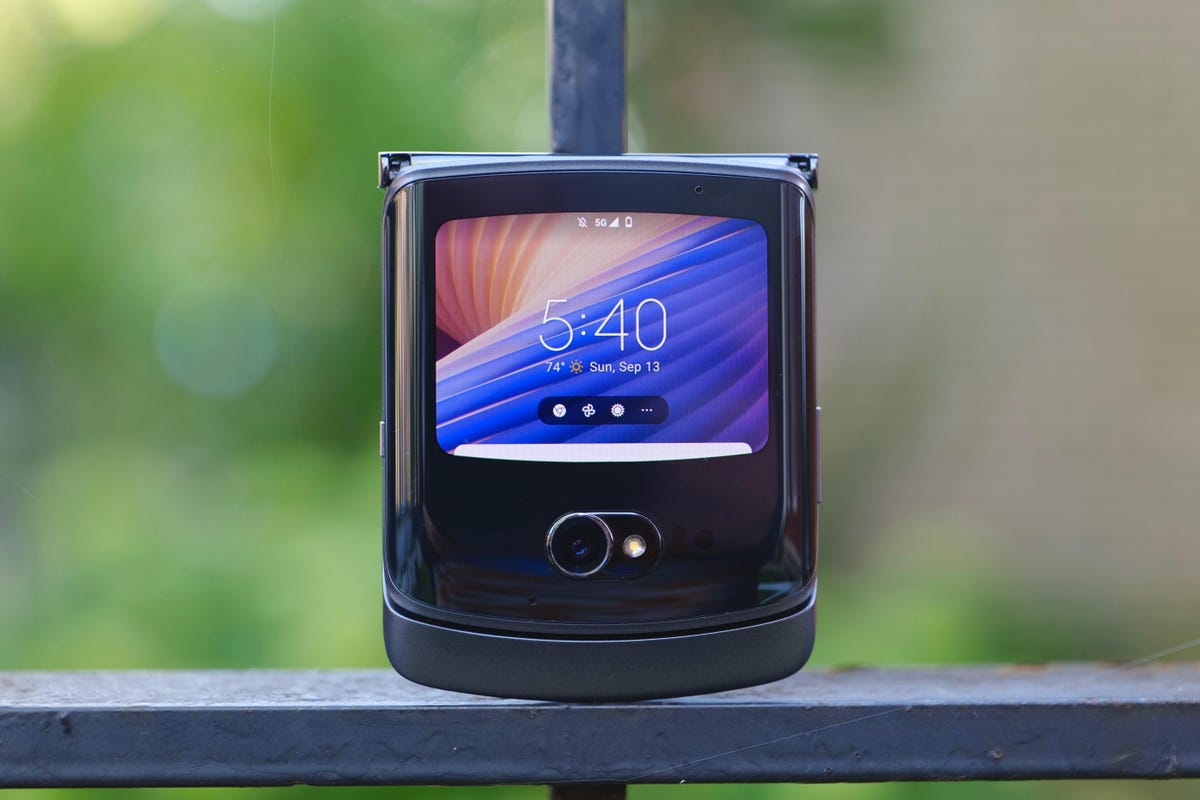
The body of the new Razr is made of aluminum and Gorilla Glass 5.
Patrick Holland/CNETThe new Razr's aluminum and Gorilla Glass 5 body feels solid
During my time with the new Razr, I used it like a regular phone. I didn't feel the need to be careful with it. I wiped the foldable screen on my jeans. I keep the phone in my pocket or in my bag.
Some of that assurance comes from its build. When you close the phone, the sides sit flush, encompassing and protecting the display. But some of that is my perception. I want to be confident that if the Razr is in a pocket with my house keys, that it won't get destroyed. That confidence and trust is huge, and I didn't feel that all-the-time when I reviewed the 2019 Razr.
The new Razr is built from aluminum and Gorilla Glass 5 and feels solid compared to the prototype feel of the February version. Also that plastic back is gone!
To reinforce the phone's robustness, Motorola invited me to visit one of their testing labs and see one of the 40 different testing machines it uses to test the Razr (wearing a mask and socially distanced, of course). I got to see a machine that folds the Razr in half to simulate years of use in just a matter of days. The idea is most people will never fold this phone enough to hit Motorola's 200,000-fold lifespan.
Read more: Motorola claims the Razr can fold 200,000 times. We get a peek at how the phone is tested

This is one of four new Motorola Razr phones on a machine that opens and closes it once every four seconds. Over the course of 10 days the phones will be folded 200,000 times.
Patrick Holland/CNETMy time with the Razr has largely been squeak-free… until Friday. I don't know if it's the humidity or what, but there's a little squeak anytime I open or close it. The only time I don't hear it is when I flick the Razr open one-handed. The squeak isn't as loud as the 2019 Razr. But when I hear it, I feel conflicted. I feel disappointed.
I asked a friend how they felt about the squeak and they said it didn't bother them. I guess when it comes to screen notches, foldable screen creases and now foldable phone squeaks, some of you will get used to these things while others will be wildly annoyed.
I should add that the squeak comes from the hinge mechanism, but doesn't indicate any mechanical problems.
Quick View display separates the Razr from the Galaxy Z Flip 5G
Perhaps my favorite feature is the Quick View display which got a lot more useful with the new Razr. Fundamentally this is where the Razr and the Galaxy Z Flip couldn't be more different. There are basically three modes to the outside display: The first is a Peek Display mode that lets you see notifications just by pressing and holding on an icon. The next is like a Peek Display plus mode where you can press and hold an icon, then swipe up to reveal multiple notifications and respond to them. The keyboard basically takes up the entire screen, but after a few uses I got better at typing on it.
But it's the third mode -- let's call it mini-Android mode -- where the true power of the Quick View display gets unleashed. When the Razr is closed and unlocked, you can swipe down to get to the control panel, swipe up to see something similar to the notification shade, swipe to the left to go to the camera and swipe right to see a grid of apps and swipe to the right again, to see contact favorites.
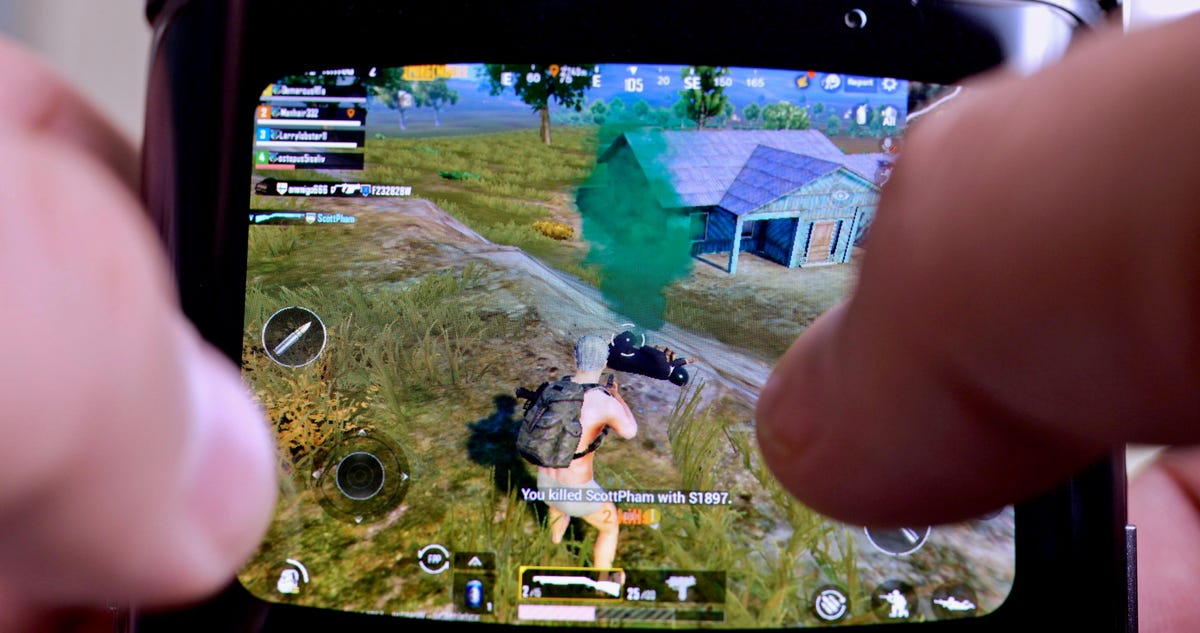
The Quick View display on the Razr is officially the smallest screen I've ever played PUBG Mobile on.
Patrick Holland/CNETThe phone can curate a list of apps that work well on the smaller external screen. Apps like Gmail, YouTube and Messages can be used complete with a mini keyboard. Also, you can go back and forth between the Quick View display and the interior display and pick right up where you were at.
You can also do what I did and go into the Manage apps setting and turn on unlimited which allowed me to try pretty much any app I wanted on the Quick View display. So I decided to try PUBG Mobile. I could barely make out the controls, but it is possible to play PUBG on the Quick View display. I also played Alto's Odyssey and Super Mario Run. Not every app is optimized for that small of a display. But this iteration of the Quick View display marks an enormous step in the right direction for Motorola.
Razr has a new 48-megapixel main camera
Then there are the cameras both of which got a solid upgrade. The selfie camera atop the internal display is much better and works great for Zoom meetings and taking selfies. Though video recording on the selfie camera does top out at 1080p.
The exterior camera has 48-megapixels and uses pixel-binning to create good 12-megapixel photos. This camera is much better than the 2019 Razr. And thanks to the optical image stabilization and a time-of-flight sensor, I got an acceptable rate of in-focus and sharp photos.
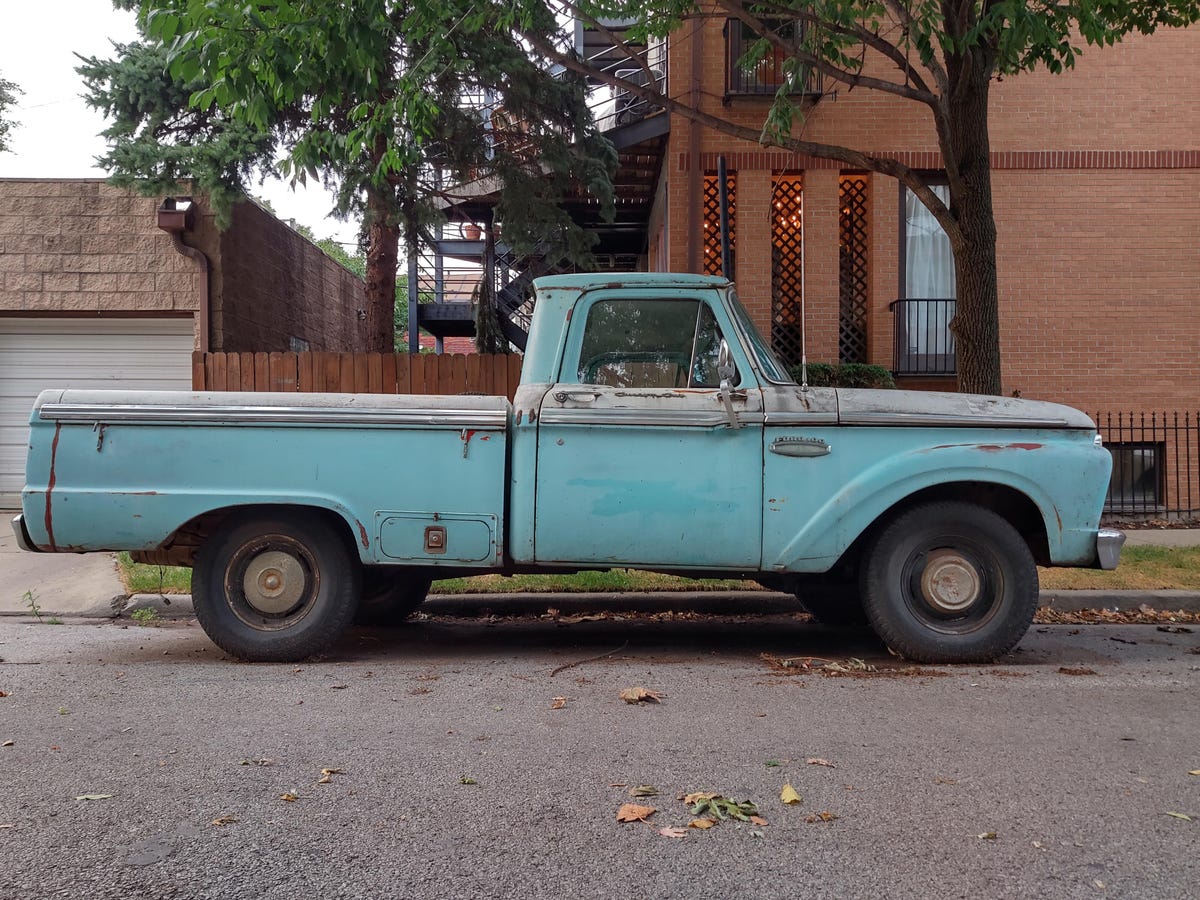
The HDR mode works rather well without it being too heavy-handed. It kept the faded blue of the pickup just right.
Patrick Holland/CNET
This was taken with the digital zoom at 2x. It's remarkable the detail it was able to capture. It also shows off the lens' natural bokeh.
Patrick Holland/CNET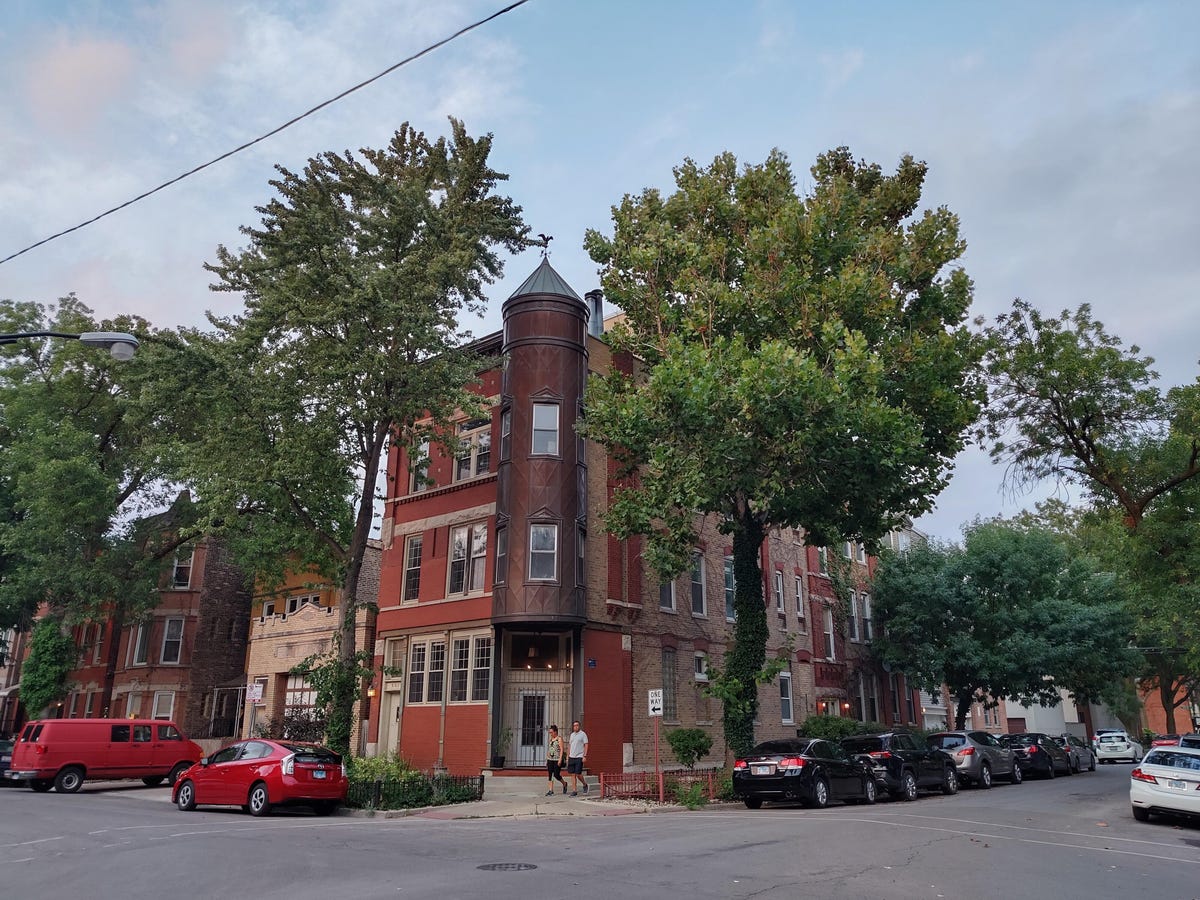
Here's another photo where the Razr went into HDR mode.
Patrick Holland/CNET
This is a selfie I took with the exterior 48-megapixel camera with the phone closed.
Patrick Holland/CNETBut the Razr's cameras are not on the same level as the iPhone 11 or Google Pixel 4A. Unless Motorola added a Note 20 Ultra-sized camera bump onto the Razr (please don't do that) there is only such room for a sensor and lens inside something this small.
Low-light and zoomed in photos are soft and look like a painting because of noise reduction. There is a Night Vision mode that can help, but I find it works best in medium-to-low lighting versus situations where it's dark.
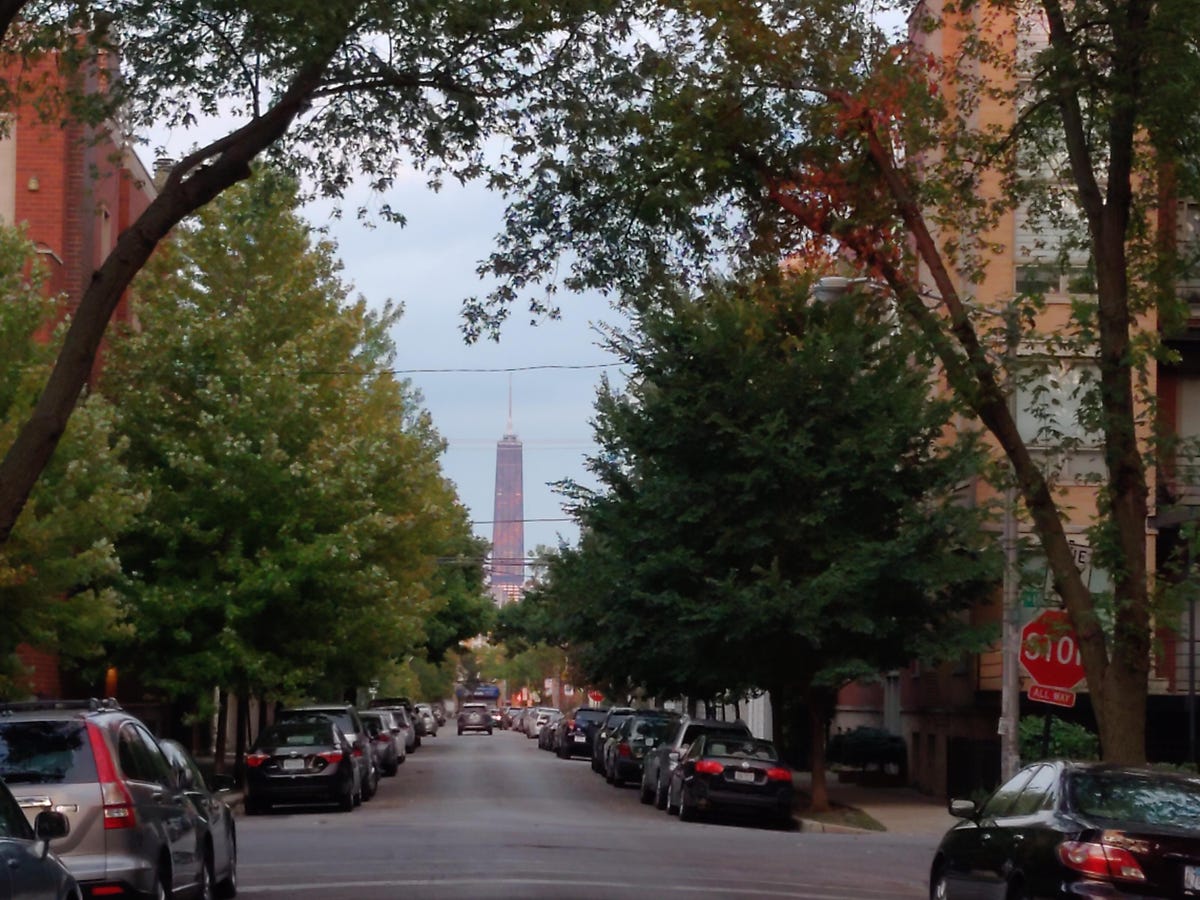
Here is a 5x digital zoom of the John Hancock building off in the distance. The details are definitely soft.
Patrick Holland/CNET
This photo was taken in the regular photo mode.
Patrick Holland/CNET
This photo was taken with Night Vision. This is the best Night Vision photo I took with the Razr. That said, the sky looks painted on.
Patrick Holland/CNETThe main camera also shoots 4K video and the quality is decent. Video definitely doesn't have the same dynamic range as photos and suffers from image noise and artifacts. But I'm happy with the clips I was able to record. Check some out video clips I shot below:
OK battery life, sub-6 5G and Snapdragon 765G
Motorola claims a benefit of using the Quick View display more is it doesn't tax battery life as bad as using the main display. And that's good news. In my use, the new Razr gets me barely through a day. I typically find myself topping off at dinner time. And that's while I'm connected to 5G. I'm getting about 7 hours, 30 minutes of screen-on time and in a test with continuous video playback on Airplane mode the Razr lasted 15 hours, 53 minutes, that's 1 hour, 50 minutes more than the 2019 Razr lasted in the same test. And that's 53 minutes more than the Galaxy Z Flip.
The new Razr has a larger battery than the 2019 Razr and some of that is to compensate for use on 5G, which can eat up battery life. The Razr can work on sub-6 flavors of 5G like on AT&T and T-Mobile. I've been testing this Razr on T-Mobile's 5G here in Chicago. Sometimes I get speeds over 100Mbps for downloads (that's outdoors) and other times I get speeds that are 4.55Mbps (that's also outdoors). Both of those results were well within the 5G coverage on T-Mobile's map and speaks more to T-Mobile's 5G network than it does the phone.
Powering all this is 8GB of RAM and a Snapdragon 765G processor. There will be some who will write the new Razr off because it doesn't have a Snapdragon 865 processor. But as we've seen in other Android phones this year, the 765G is a solid processor. In the Razr, it handled gaming, videos, photo edits, multitasking really well. And in benchmark tests, the Razr scored right on par with the LG Velvet.
3DMark Slingshot Unlimited
Motorola Razr (2020)
Motorola Razr (2019)
Samsung Galaxy Z Flip
Note:
Longer bars indicate better performanceGeekbench v.5.0 single-core
Note:
Longer bars indicate better performanceGeekbench v.5.0 multicore
Motorola Razr (2020)
Motorola Razr (2019)
Samsung Galaxy Z Flip
Note:
Longer bars indicate better performanceEven with all these improvements, it's hard to recommend a $1,400 especially one that is still very much a concept waiting to live up to its hype in the real world. The same can be said about the Galaxy Z Flip 5G. That said, I'm excited for Motorola and hope they make as big a step forward with the next Razr as the company did with this one.
Motorola Razr (2020) specs verus Motorola Razr (2019), Samsung Galaxy Z Flip, Samsung Galaxy Z Fold 2
| | Motorola Razr (2020) | Motorola Razr (2019) | Samsung Galaxy Z Flip | Samsung Galaxy Z Fold 2 |
|---|---|---|---|---|
| Display size, resolution | Internal: 6.2-inch, foldable pOLED; 2,142x876p pixels (21:9) / External: 2.7-inch glass OLED, 800x600-pixels (4:3) | Internal: 6.2-inch, foldable pOLED; 2,142x876p pixels (21:9) / External: 2.7-inch glass OLED, 800x600-pixels (4:3) | Internal: 6.7-inch FHD+ Dynamic AMOLED; 2,636x1,080-pixels / External: 1.1-inch Super AMOLED; 300x112-pixels | External 6.2-inch Dynamic AMOLED; Internal: 7.6-inch Dynamic AMOLED; External: 2260 x 816 pixels Internal: 2208 x 1768 |
| Pixel density | 373ppi (internal screen) | 373ppi (internal screen) | 425ppi (internal) / 303ppi (external) | 386ppi + 373ppi |
| Dimensions (Inches) | Folded: 2.86x3.61x0.63 in, Unfolded: 2.86x6.66x0.31 in | Unfolded: 6.8x2.8x0.28 in / Folded: 3.7x2.8x0.55 in | Folded: 2.99x3.44x0.62 ~ 0.68 in / Unfolded: 2.99x6.59x0.27 ~0.28 in | Folded: 2.67x6.26x0.6 in (Hinge) ~ 0.54 in(Sagging), Unfolded: 5.04x6.26x0.27 in(Frame) ~ 0.23 in(Screen) |
| Dimensions (Millimeters) | Folded: 72.6x91.7x16mm, Unfolded: 72.6 x 169.2 x 7.9mm | Unfolded: 172x7 2x6.9mm / Folded: 94x72x14mm | Folded: 73.6x87.4x15.4 ~17.3 mm / Unfolded: 73.6x167.3x6.9 ~ 7.2 mm | Folded: 68.0x159.2x16.8mm (Hinge) ~ 13.8mm(Sagging), Unfolded: 128.2x159.2x6.9mm(Frame) ~ 6.0mm(Screen) |
| Weight (Ounces, Grams) | 6.77 oz; 192g | 7.2 oz; 205g | 6.46 oz; 183g | 9.95 oz; 282 grams |
| Mobile software | Android 10 | Android 9 Pie | Android 10 | Android 10 |
| Camera | 48-megapixel (exterior) | 16-megapixel external (f/1.7, dual pixel AF), 5-megapixel internal | 12-megapixel (wide-angle), 12-megapixel (ultra wide-angle) | 12-megapixel (main) + 12-megapixel (wide angle) + 12 megapixel (telephoto) |
| Front-facing camera | 20-megapixel (interior) | Same as main 16-megapixel external | 10-megapixel | 10-megapixel, 10-megapixel |
| Video capture | 4K | 4K | 4K | 4K |
| Processor | Qualcomm Snapdragon 765G | Qualcomm Snapdragon 710 | Qualcomm Snapdragon 855 Plus | Snapdragon 865 Plus |
| Storage | 256GB | 128GB | 256GB | 256GB |
| RAM | 8GB | 6GB | 8GB | 12GBRAM |
| Expandable storage | No | None | None | No |
| Battery | 2,800 mAh | 2,510 mAh | 3,300 mAh | 4,500 mAh |
| Fingerprint sensor | Back | Below screen | Power button | Side |
| Connector | USB-C | USB-C | USB-C | USB-C |
| Headphone jack | No | No | No | No |
| Special features | 5G enabled, Foldable display, Dual SIM, Time of flight sensor, OIS exterior camera, splashproof | Foldable display, eSIM, Motorola gestures, splashproof | Foldable display; wireless PowerShare; wireless charging; fast charging | 5G enabled, Foldable display, 120Hz refresh rate, wireless charging support, |
| Price off-contract (USD) | $1,400 | $1,499 | $1,380 | $2,000 |
| Price (GBP) | £1,399 | £1,000 | £1,300 | £1,799 |
| Price (AUD) | Converts to AU$2,470 | AU$1,799 | AU$1,999 | AU$2,999 |
Originally published Sept. 14
Source
Tags:
- Motorola Razr 2020 Review The Iconic Flip Phone Has Done It
- Motorola Razr 2020 Review The Iconic Flip Phone Has Done Synonym
- Motorola Razr 2020 Review The Iconic Flip Phone Has Done Lemon
- Motorola Razr 2020 Review The Iconic Flip Phone Has Do ne Tense
- Motorola Razr 2020 Reviews
- Motorola Razr 2020 Specs
- Motorola Razr 2020 For Sale
- Motorola Razr Review
